Introduction
In the fast-paced world of technology startups, many founders find themselves grappling with a common challenge: how to carve out a unique online presence. It’s a daunting task, especially as digital design evolves at lightning speed. The pressure to keep up with the latest web design trends can feel overwhelming, and the stakes are high. Without a distinctive online identity, startups risk losing potential customers and failing to build lasting brand loyalty.
But what if there was a way to not only navigate these trends but to thrive in them? This article is here to help. We’ll explore ten innovative web design trends that tech startups in Washington, DC, can adopt. These trends aren’t just about aesthetics; they’re about creating meaningful connections with your audience. By embracing these strategies, you can foster relationships that go beyond mere transactions, nurturing a community around your brand.
Let’s embark on this journey together, discovering how to stand out in a crowded marketplace while building a loyal user base.
RNO1: Pioneering Radical Digital Experiences in Web Design
In today’s fast-paced digital world, many tech startup founders struggle to create a meaningful online presence that resonates with their audience. This challenge can feel overwhelming, especially when trying to keep up with the constant changes in technology and consumer expectations. It’s not just about having a website; it’s about crafting an experience that truly connects with people.
At RNO1, we understand the weight of these challenges. We’ve seen firsthand how difficult it can be for brands to navigate the complexities of the digital landscape. That’s why we’re committed to helping you not just meet your goals but exceed them. Our approach combines advanced technology with creative concepts, ensuring that every project we undertake not only fulfills your expectations but also sets new benchmarks in the industry.
Imagine having a partner who not only understands your vision but also empowers you to sustain a vibrant online presence. With our unique subscription models, we provide the tools and support you need to thrive in this ever-evolving environment. This isn’t just about boosting brand involvement; it’s about building a lasting relationship with your audience.
As we look toward 2025 and beyond, RNO1 stands ready to be your essential ally. Together, we can transform your digital challenges into opportunities for growth and connection. Let’s embark on this journey together, ensuring that your brand not only survives but flourishes in the digital age.
User Experience (UX) Design: Elevating Customer Engagement
User interaction (UX) development is a significant challenge for many technology startups striving to connect meaningfully with their audience. It’s not just about having a website; it’s about web design dc that creates an experience which feels intuitive and engaging. When navigation is clunky or layouts are unresponsive, it can lead to frustration, pushing potential customers away. This is a pain point that many founders face, and it can feel overwhelming.
At RNO1, we understand the importance of nurturing these connections. Through transformative collaborations, like our work with RentMethod, we’ve seen firsthand how effective UX can lead to remarkable outcomes. Our expertise played a crucial role in RentMethod’s successful acquisition by Airbnb, showcasing how impactful user experiences can drive significant business results. This isn’t just theory; it’s a testament to the power of prioritizing user-centric features.
Moreover, our partnerships with Spring Labs and Opus9 further illustrate our commitment to enhancing digital interactions. These collaborations have led to meaningful advancements in engagement, proving that when we focus on the user, everyone benefits. In fact, by 2025, 70% of companies plan to hire UX professionals, reflecting a growing recognition of its vital role in fostering engagement.
Integrating customer feedback into the development process is essential. It ensures that the final product aligns with the needs and preferences of your target audience, ultimately leading to increased engagement and conversion rates. Companies that effectively apply UX principles can see conversion rate boosts of up to 400%. This isn’t just about numbers; it’s about creating satisfaction and loyalty among your customers.
Consider this: studies show that 88% of visitors won’t return to a website after a negative experience. This highlights the critical importance of UX design in web design dc for retaining customers. As startups navigate the competitive landscape, embracing trends like mobile optimization and AI-driven personalization will be vital for building lasting relationships with your audience.
At RNO1, we’re here to support you on this journey. Together, we can create user experiences that not only meet but exceed expectations, fostering a community of loyal customers who feel valued and understood.
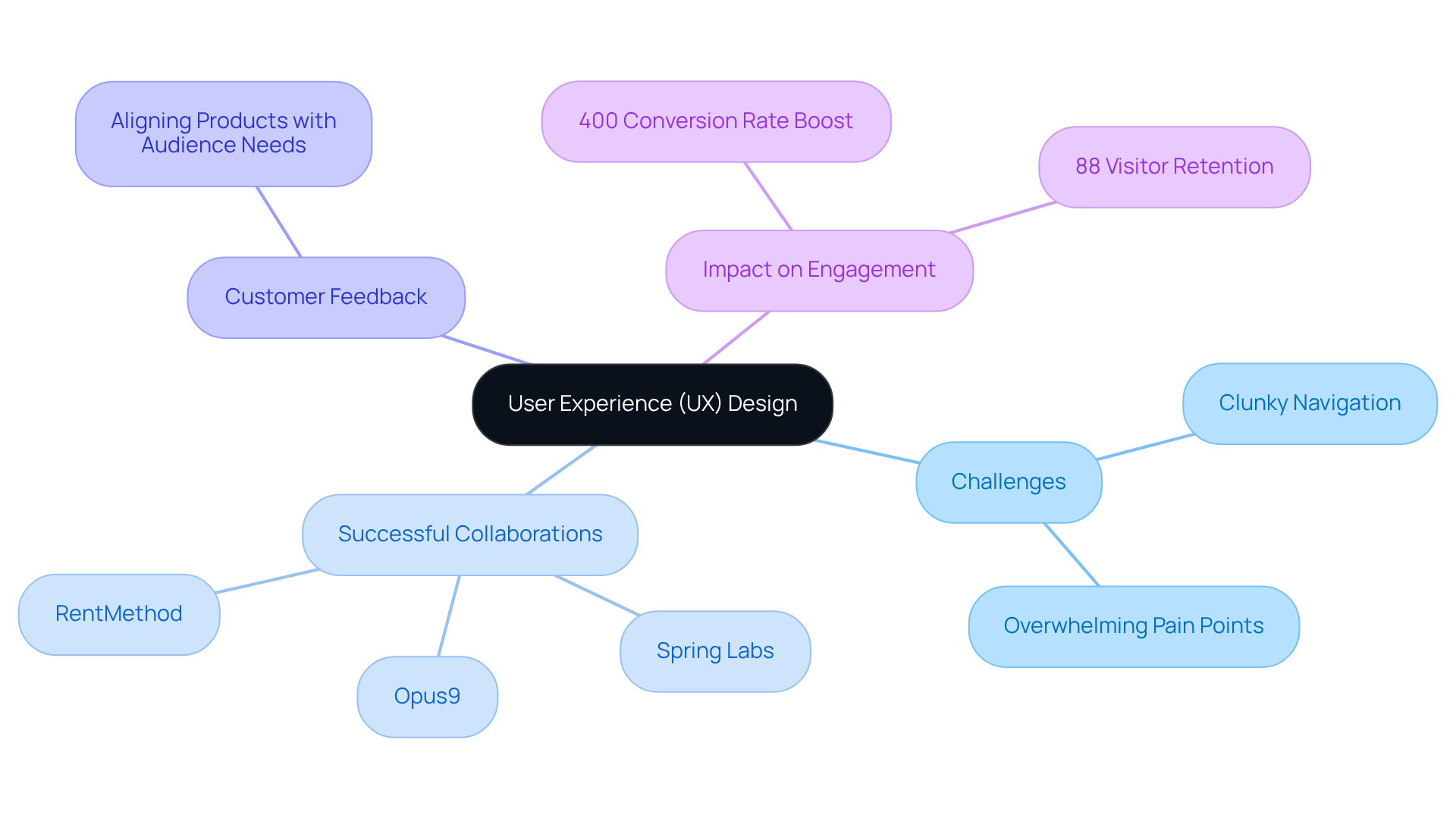
Augmented Reality (AR): Transforming User Interaction
Augmented reality (AR) is changing the way we connect with digital content, and it’s a game-changer for startups. Many founders face the challenge of engaging customers in a crowded digital space, and it can feel overwhelming. Imagine how it feels when your audience isn’t fully invested in what you offer. It’s frustrating, isn’t it?
AR offers a solution by superimposing digital information onto the physical world, creating unique interactions that traditional web design simply can’t match. This technology can help startups craft interactive product demonstrations, virtual try-ons, and immersive storytelling experiences. It’s not just about showcasing products; it’s about fostering genuine connections with your audience. In fact, studies show that:
- 56% of consumers feel more confident in a product's quality when AR is involved.
- 61% prefer shopping at retailers that offer AR options.
Consider the success of virtual fitting rooms in fashion retail. They’ve proven to enhance customer retention by providing personalized and engaging shopping experiences. This is the kind of innovation that can make a real difference for your business. By incorporating AR into your digital strategy, you’re not just improving engagement; you’re nurturing customer loyalty in a meaningful way.
As you explore these possibilities, remember that you’re not alone in this journey. Embracing AR can be a powerful step toward creating a more engaging and supportive shopping experience for your customers.

Sustainable Web Design: Aligning with Eco-Conscious Consumers
Sustainable web design is becoming increasingly important as more consumers seek out eco-friendly practices. In 2025, a staggering 70% of online businesses will prioritize having a mobile-friendly website to boost sales. This not only enhances the customer experience but also helps reduce energy consumption.
Imagine this: 53% of mobile users abandon sites that take longer than three seconds to load. That’s a significant loss for any startup. Moreover, 53% of shoppers say that website load speed directly impacts their loyalty to a brand. It’s clear that optimizing images to improve loading speeds is crucial.
But there’s more. By utilizing green hosting solutions, startups can significantly lower their carbon footprints. This aligns perfectly with the growing expectation from consumers for brands to adopt sustainable practices. Efficient coding can further minimize energy use, enhancing a brand's eco-friendly image.
When technology companies show their commitment to sustainability, they attract environmentally conscious consumers and stand out in a crowded market. It’s heartening to know that 51% of consumers are willing to spend more on sustainable products, even when those products come with a 28% premium compared to traditional options. This reveals a distinct market advantage for brands that prioritize eco-friendly online development.
As you navigate these challenges, remember that adopting sustainable practices not only benefits the planet but also resonates deeply with your audience. Together, we can create a more sustainable future.
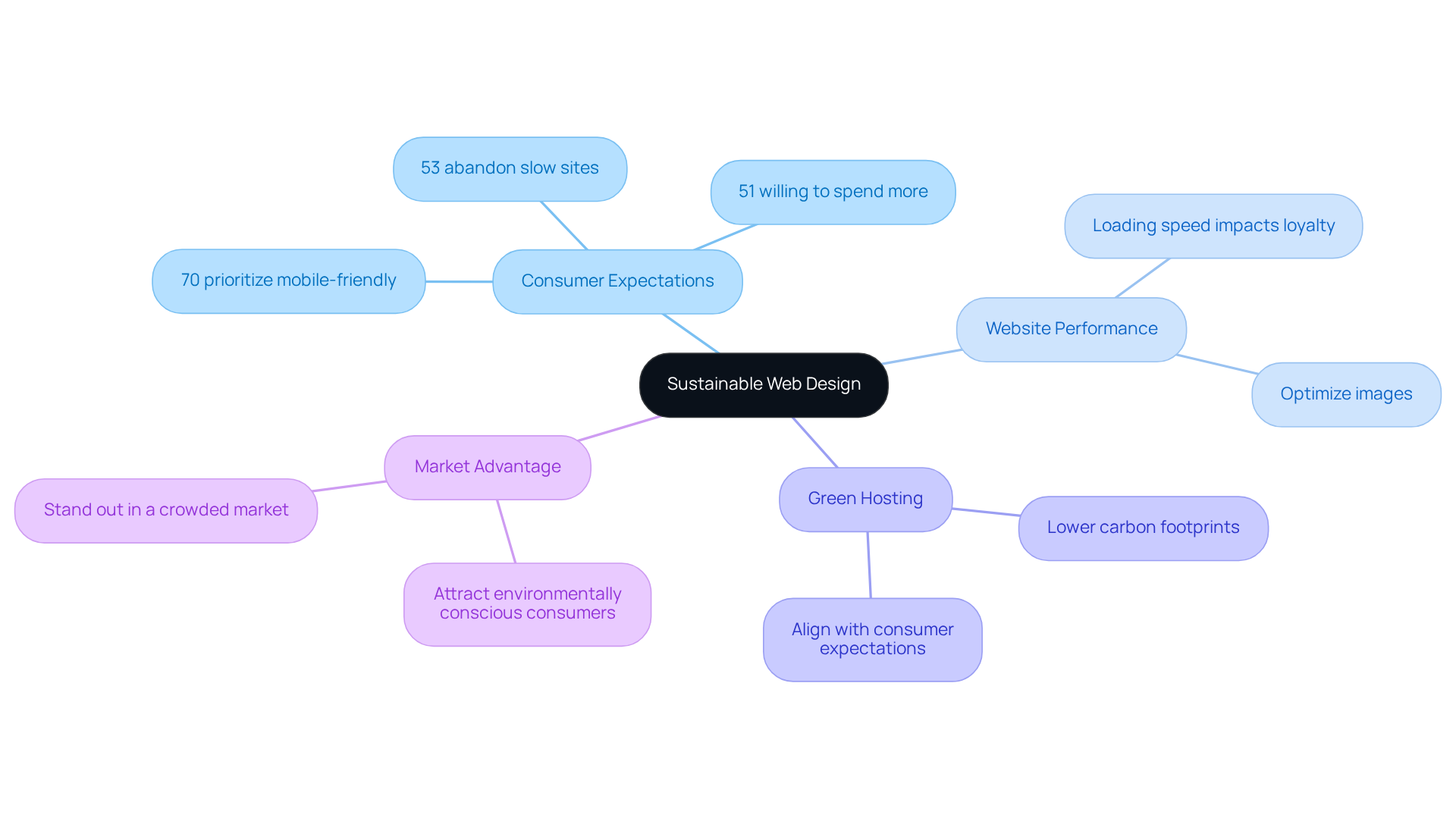
Mobile-First Design: Catering to On-the-Go Users
As we look ahead to 2025, it’s clear that mobile devices will account for over 63.8% of web traffic. For technology companies, this presents a significant challenge: how do we embrace a mobile-first design strategy? This approach isn’t just about aesthetics; it’s about ensuring that our key features shine on smaller screens, making them accessible and user-friendly for mobile audiences.
Imagine a potential customer trying to navigate your website on their smartphone, only to be met with frustration. This scenario is all too common, and it can lead to lost opportunities. When interactions across devices are seamless, customer satisfaction and engagement soar. We must remember that successful mobile-first design not only enhances accessibility but also caters to the growing number of individuals who rely on their smartphones for online interactions.
In a world where nearly 90% of online users won’t return to a website after a negative experience, and 57% are less likely to recommend a business following a poor mobile experience, prioritizing mobile optimization is not just beneficial - it’s essential. This is especially true in the e-commerce sector, where mobile devices now represent a staggering 71.8% of traffic. New businesses must ensure their platforms are mobile-optimized to effectively capture and retain customers.
At RNO1, we understand these challenges deeply. We’re here to support you in navigating this landscape, ensuring that your mobile strategy not only meets the demands of today’s users but also fosters a positive experience that keeps them coming back. Together, we can create a digital environment where your customers feel valued and engaged.
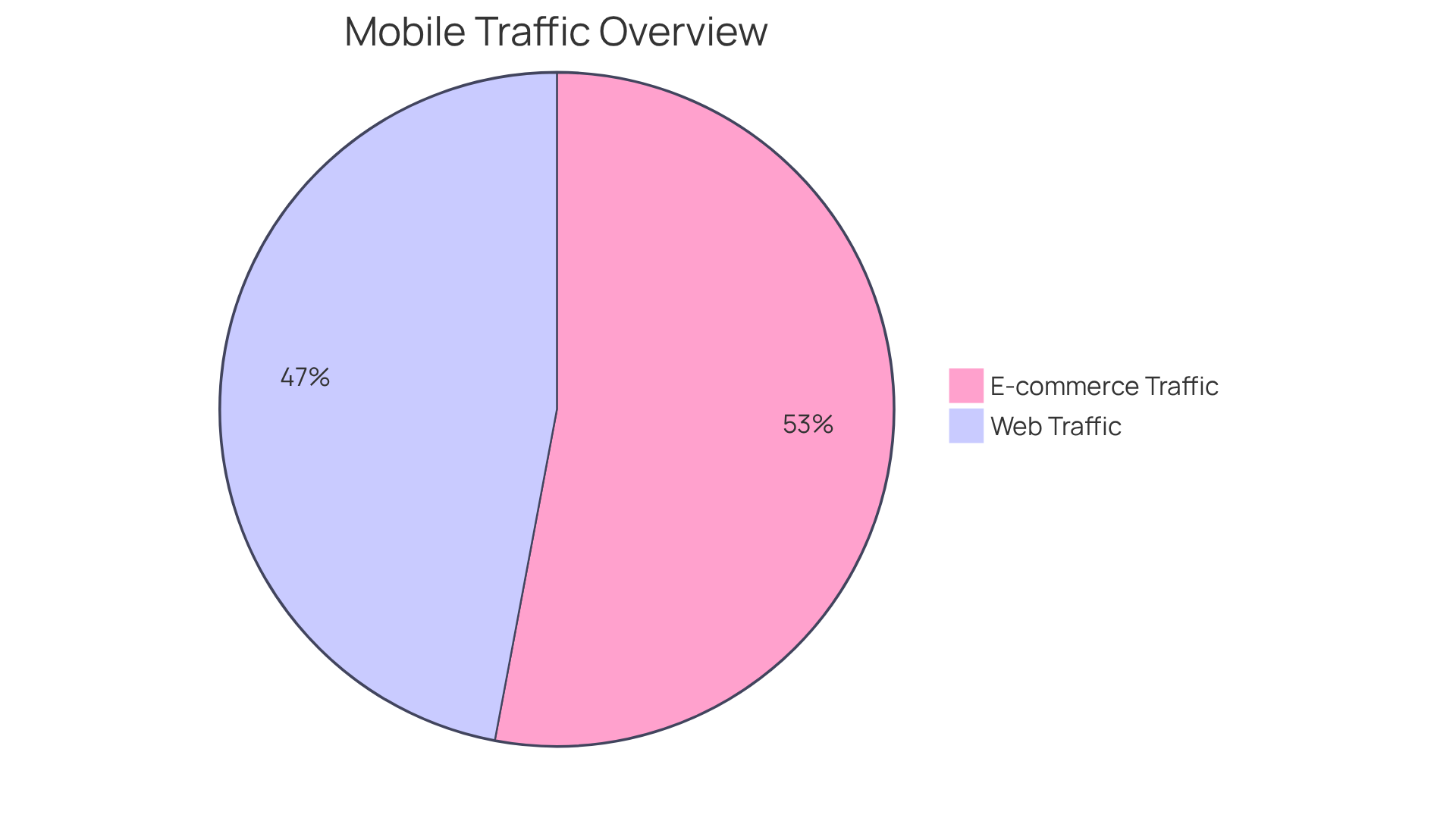
Bold Typography: Enhancing Brand Identity
Bold typography plays a vital role in shaping brand identity in web design, especially for technology companies like those at RNO1. Many startups struggle to stand out in a crowded market, and the right font can make all the difference. When distinctive fonts and styles are chosen thoughtfully, they create a visual presence that not only grabs attention but also conveys the brand's message effectively.
At RNO1, we understand that every typographic choice is made with the goal of enhancing brand marketability through our Return On Design & Digital (RODD) strategies. It’s concerning to note that research by Adobe reveals that 38% of individuals will disengage from a website if the content or layout is unattractive. This statistic underscores the importance of typography in maintaining engagement and connection with your audience.
Moreover, brands that prioritize customer experience, including typography, can experience up to a 40% increase in client loyalty, as highlighted by Econsultancy. This isn’t just about aesthetics; it’s about building relationships. Thoughtful typography enhances readability and strengthens brand recognition, fostering a deeper bond between individuals and the brand.
Take, for example, RNO1's work on the 'Letter Bounce' case study. Here, unique typographic choices helped create a memorable identity that truly resonates with the target audience. As we look ahead to 2025, the significance of typography in web creation and branding will only grow, shaping how startups present themselves in a competitive landscape.
If you’re a startup founder, consider how unique typography can bolster your brand identity and engage your audience more effectively. We’re here to support you in this journey, ensuring your brand not only stands out but also connects meaningfully with those you aim to serve.
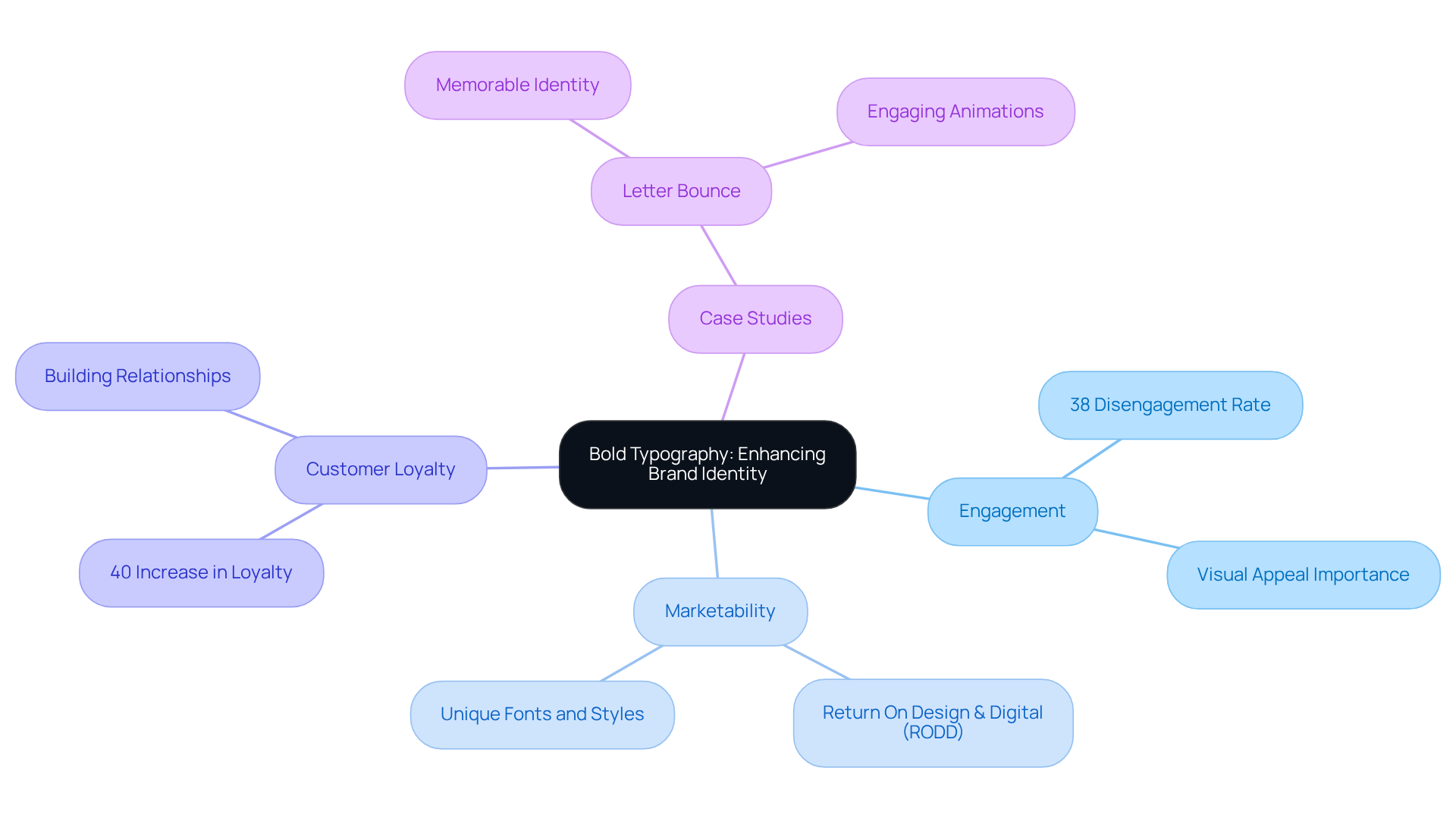
Minimalism: Simplifying User Experience
In the world of web creation, many startups face a common challenge: the overwhelming clutter of information and design elements. This clutter can lead to cognitive overload for visitors, making it difficult for them to focus on what truly matters. Imagine a potential customer landing on your site, only to be bombarded with distractions that pull their attention away from your core message. It’s frustrating, isn’t it?
But there’s a way to alleviate this pain. By embracing minimalism in your web design, you can create a clean and intuitive experience that guides visitors toward their goals. Focusing on essential content and functionality in web design not only enhances usability but also aligns with a modern aesthetic that resonates with those who appreciate simplicity.
At RNO1, we understand the emotional journey of tech startup founders. We know that every decision counts, and a streamlined website can make all the difference in connecting with your audience. Let’s work together to craft a digital space that reflects your vision while ensuring your visitors feel welcomed and understood. Together, we can transform your online presence into a nurturing environment that fosters engagement and drives success.
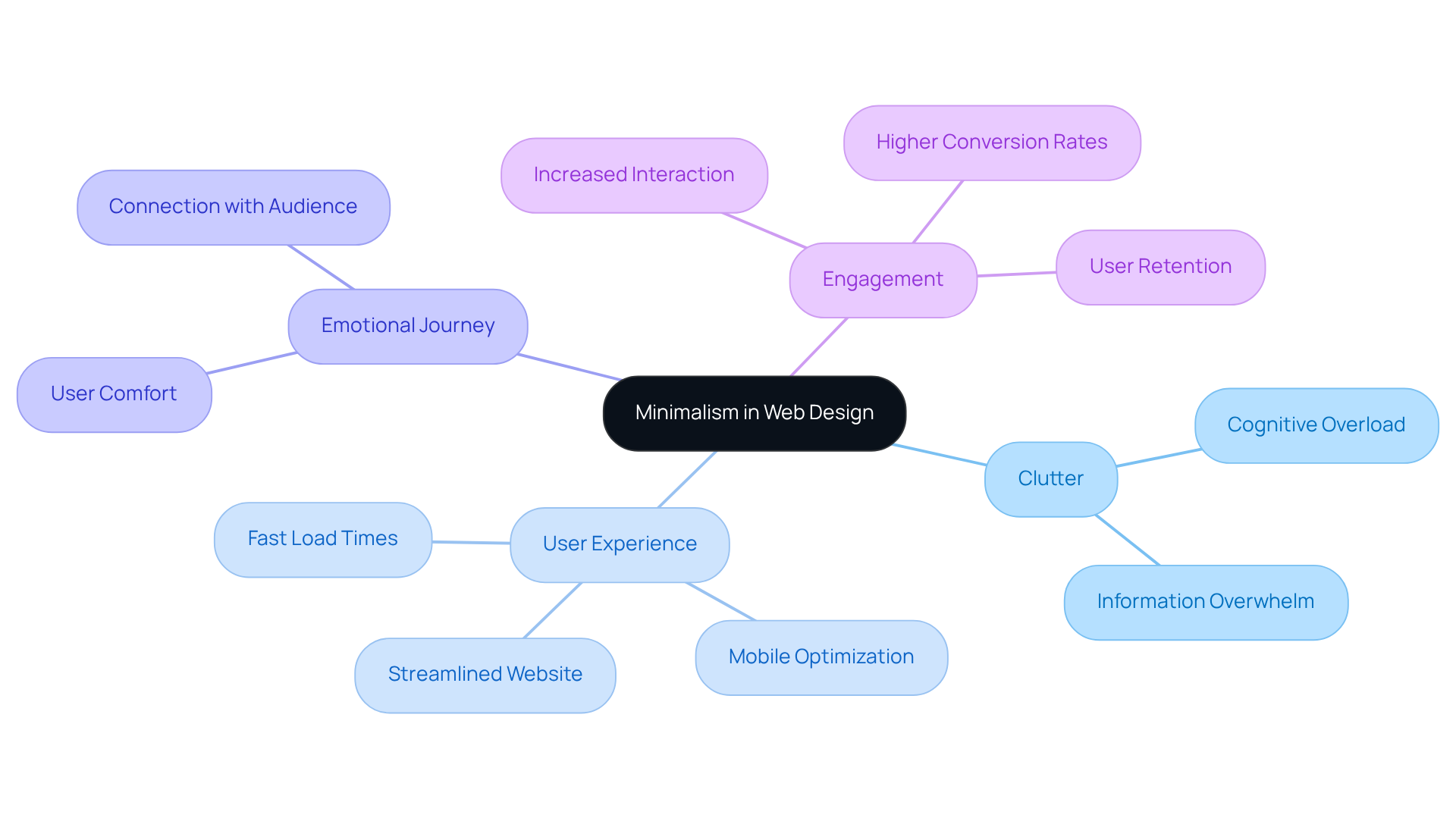
Dark Mode: Customizing User Experience
Dark mode has emerged as a comforting solution for many, offering a visually pleasing alternative that alleviates eye strain and enhances readability. For startups, incorporating dark mode options means providing a customizable experience that truly caters to individual preferences. This thoughtful feature not only boosts usability but also aligns with the latest design trends, making websites more inviting for visitors.
Imagine the relief of users who find themselves squinting at bright screens late at night. Studies reveal that dark mode can increase engagement by 30%, while also improving usability and performance. Thriving new businesses, like those highlighted in the case study on dark mode implementation in corporate websites, recognize its potential to elevate client satisfaction and retention.
Moreover, offering a dark mode choice can significantly enhance the overall browsing experience. After all, 60% of shoppers prioritize a store's ease of use in design. To ensure that dark mode functionalities truly resonate, it’s essential for new businesses to conduct accessibility testing, achieving optimal contrast ratios and improving usability for everyone. By embracing this approach, startups can foster a more inclusive environment that meets the diverse needs of their users.
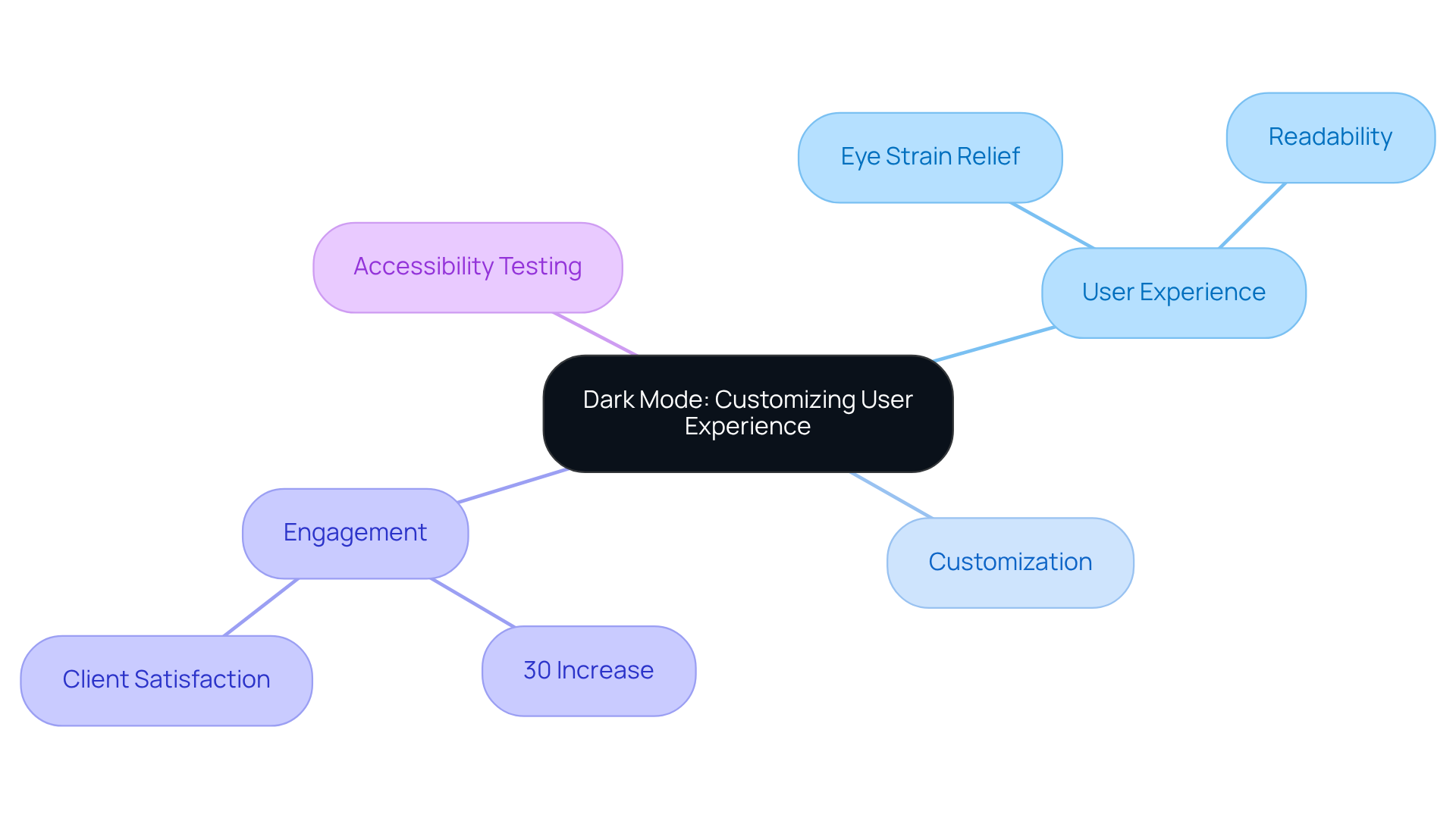
Chatbots: Enhancing Customer Service and Engagement
Chatbots are reshaping customer service, offering immediate assistance and personalized interactions that are essential for technology companies today. Many startups struggle with engaging their audience effectively and streamlining communication. This is where chatbots come in, providing a solution that not only enhances interaction but also simplifies the process. By automating responses to common inquiries, these intelligent systems allow businesses to use their resources more wisely, ensuring that customers receive timely help when they need it most.
Imagine the relief of your customers when they can get answers right away, without the frustration of waiting for a human agent. This immediate support not only boosts customer satisfaction but also builds loyalty. In fact, studies show that 62% of consumers prefer chatting with a bot rather than waiting for a human. For startups, this can be a game-changer. Businesses that have embraced chatbots report a 35% reduction in average handling time, which translates to greater operational efficiency.
As Candace Marshall, Vice President of Product Marketing at AI and Automation, wisely points out, "AI customer service tools will continue to become more sophisticated, but they’re already extremely advanced." The global chatbot market is on track to reach $455 million by the end of 2027, highlighting the urgency for startups to adopt this technology now. Take, for instance, the Barking & Dagenham Council, which implemented an AI assistant and achieved an impressive 533% ROI. This real-world example illustrates the tangible benefits chatbots can bring to customer service and operational efficiency.
However, it’s important to recognize that challenges exist. A significant 52% of individuals report misunderstandings during chatbot interactions. As the landscape of customer service evolves, embracing chatbot technology is not just beneficial; it’s essential for startups looking to thrive in a competitive market. By integrating chatbots, you’re not just improving efficiency; you’re also nurturing a better experience for your customers, paving the way for lasting relationships.
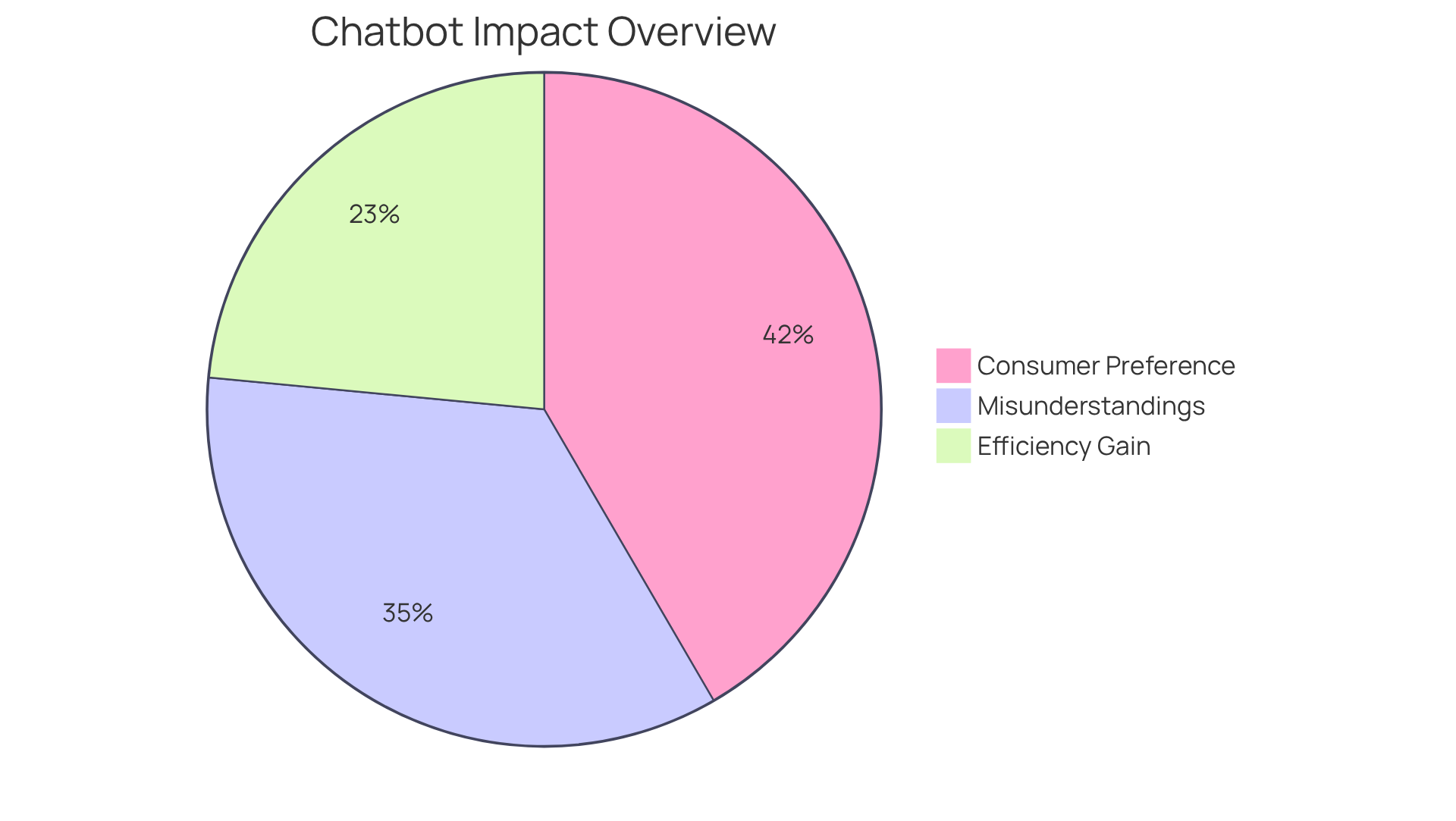
Accessibility: Ensuring Usability for All Users
Accessibility in web creation is a pressing concern that affects everyone, especially those with disabilities. Imagine trying to navigate a website that isn’t designed with your needs in mind. It’s frustrating, isolating, and can even prevent individuals from accessing vital information or services. For startups, embracing inclusive development practices isn’t just a nice-to-have; it’s essential. By providing alternative text for images, ensuring keyboard navigability, and maintaining adequate color contrast, you can create a welcoming digital space for all users.
The implications of neglecting accessibility are significant. In 2025, the focus on accessibility is expected to intensify. Companies that prioritize it are likely to outperform their competitors by four times in total shareholder returns, as highlighted by Accenture. This isn’t just about doing the right thing; it’s about smart business. Organizations investing in accessibility see an impressive return of $100 for every $1 spent, according to Gartner. This underscores the financial benefits of inclusive design, which can lead to a broader audience reach and increased customer loyalty.
Consider the successful examples of tech companies that have integrated features like assistive navigation modes and cognitive disability support. These enhancements significantly improve user experiences, making digital environments more engaging for everyone. Yet, it’s alarming to note that 87% of Shopify stores have accessibility violations. This statistic emphasizes the urgent need for new businesses to prioritize accessibility from the start.
By committing to these practices, startups can show their dedication to inclusivity. It’s not just about compliance; it’s about fostering a more engaging and accessible digital environment. Let’s work together to ensure that everyone, regardless of their abilities, can navigate and enjoy the digital world. Your commitment to accessibility can make a profound difference, creating a community where everyone feels valued and included.
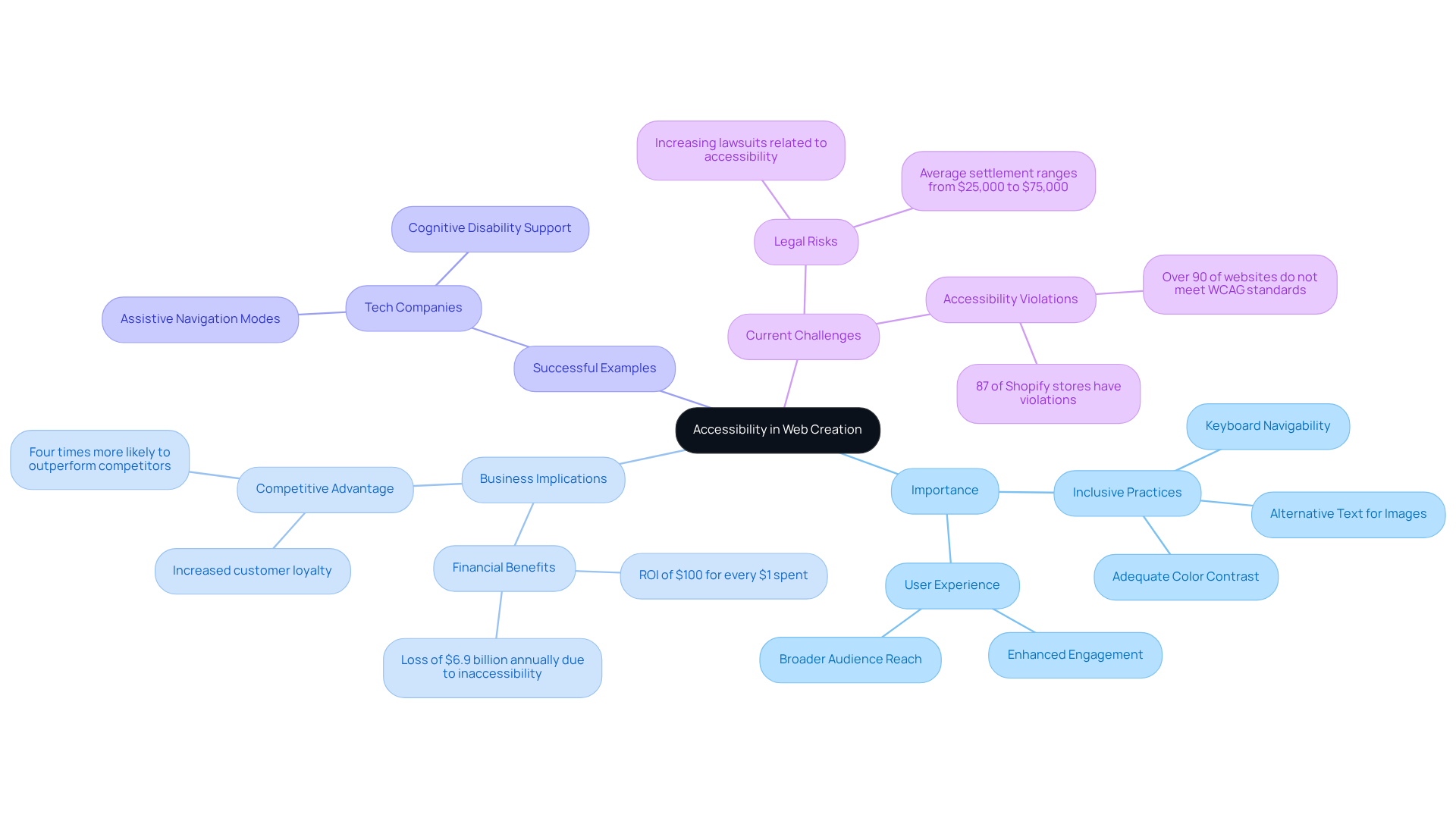
Conclusion
For tech startups, embracing the latest web design trends isn’t just a choice; it’s a necessity for building a meaningful online presence and truly connecting with your audience. Many founders face the daunting challenge of standing out in a crowded digital landscape, and the insights shared here highlight just how crucial it is to prioritize user experience, innovative technologies, and sustainable practices. By adopting these trends, you can enhance customer satisfaction and cultivate lasting relationships that foster loyalty and growth.
Consider the strategies we’ve discussed, like integrating user-friendly designs that embrace mobile-first and minimalist approaches. These cater to the needs of today’s consumers, making their experience seamless and enjoyable. Moreover, leveraging technologies such as augmented reality and chatbots can significantly boost user engagement and streamline customer service. As you navigate this competitive terrain, investing in accessibility and sustainability will resonate deeply with eco-conscious and diverse audiences, positioning your startup as a leader in your field.
Ultimately, the journey toward a successful digital presence is about commitment-commitment to continuous improvement and innovation. By embracing these web design trends, you can transform your online platforms into vibrant spaces that not only attract customers but also foster a sense of community and belonging. The time to act is now; seize this opportunity to create impactful digital experiences that will set your brand apart in the evolving landscape of 2025 and beyond. Remember, you’re not alone in this journey-together, we can navigate the challenges and celebrate the successes.
Frequently Asked Questions
What challenges do tech startup founders face in creating an online presence?
Tech startup founders often struggle to create a meaningful online presence that resonates with their audience, especially amidst constant changes in technology and consumer expectations.
How does RNO1 help brands navigate digital challenges?
RNO1 combines advanced technology with creative concepts to help brands not only meet but exceed their goals, ensuring that projects fulfill expectations and set new industry benchmarks.
What is the significance of user experience (UX) design for technology startups?
UX design is crucial for technology startups as it creates intuitive and engaging experiences. Poor navigation and unresponsive layouts can frustrate users, leading to a loss of potential customers.
Can you provide an example of RNO1's impact on UX design?
RNO1's collaboration with RentMethod played a significant role in its successful acquisition by Airbnb, demonstrating how effective UX can drive substantial business results.
Why is integrating customer feedback important in UX development?
Integrating customer feedback ensures that the final product aligns with the needs and preferences of the target audience, which can lead to increased engagement and conversion rates.
What are the potential benefits of applying UX principles?
Companies that effectively apply UX principles can see conversion rate boosts of up to 400%, leading to greater customer satisfaction and loyalty.
What is the role of augmented reality (AR) in enhancing user interaction?
AR transforms user interaction by superimposing digital information onto the physical world, creating unique and engaging experiences that traditional web design cannot match.
How does AR influence consumer confidence and shopping preferences?
Studies show that 56% of consumers feel more confident in a product's quality when AR is involved, and 61% prefer shopping at retailers that offer AR options.
How can incorporating AR into a digital strategy benefit startups?
Incorporating AR can enhance customer retention by providing personalized and engaging shopping experiences, thereby nurturing customer loyalty.
What is RNO1's commitment to supporting startups in their digital journey?
RNO1 is dedicated to helping startups create user experiences that exceed expectations and foster a community of loyal customers who feel valued and understood.




